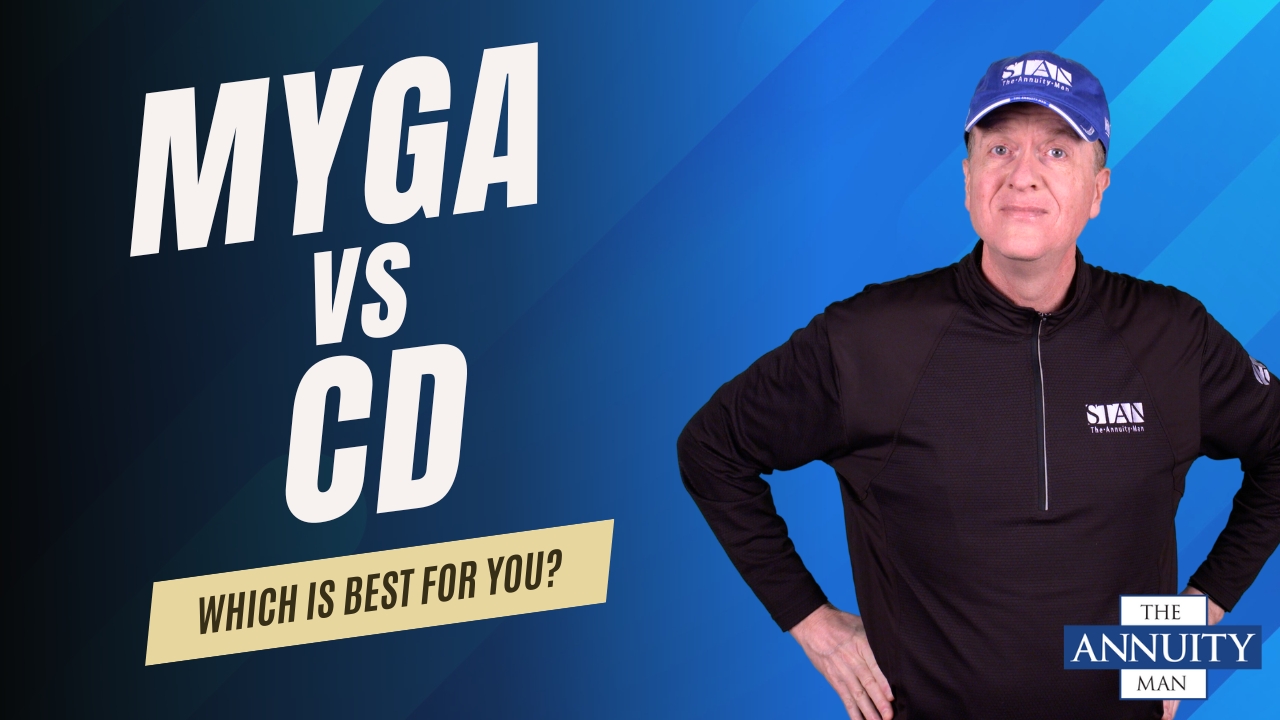Table of Contents
MYGA Death Benefits Explained

Understanding How MYGAs Work
The focus today is Multi-Year Guaranteed Annuities and explaining the death benefits. Yes, we do have to explain it because when you're looking at the CD type products, you have to understand how they work and understand when we quote all carriers, why some carriers finish at the top, and how to make a decision that's informed and based on your timeframe. Nod your head, nod your head again.
Let's talk about Multi-Year Guarantee Annuities as a product type. First of all, you already own the best annuity on the planet, Social Security. But if you've ever owned a CD, a certificate of deposit that you either bought at the bank or the brokerage firm or whoever, the CD pays a percent annually. That's for a specific duration that you choose. You could buy three year CD that pays X percentage.
Right now, at the time of this taping, if you look at the date, CD rates are pretty low just because the tenure of treasury at the time of this taping is at perceived low levels, so the yield isn't good for the baby boomers. All 10,000 are hitting age 65 every single day. What's the alternative? The alternative is what's called a Multi-Year Guaranteed Annuity. It is the annuity industries' version of a CD.
CDs vs MYGAs
Now, let's talk about CDs and Multi-Year Guarantee Annuities just as a comparison. FDIC backs CDs, F stands for federal. That is the best coverage that you can get. With Multi-Year Guarantee Annuities, you have to decide on the claims-paying ability of that annuity company’s issuing company/carrier. Yes, there are state guarantee funds that backup up to a specific level for each specific state. But forget about that for a second. You need to decide on the claims-paying ability of that Multi-Year Guaranteed Annuity.
We have the best live 24/7 feed of the country’s top MYGAs, Multi-Year Guarantee Annuities. If you go to my homepage, you’ll see the rates listed, and you can click the button to see rates. You're going to put in your state of residence. There is a drop-down that shows all the states, and then you're going to choose the duration. Whether it's two years, three years, four years, seven years, five years, ten years, whatever. Then hit "See rates,” Then it will pop up on your screen, the best rates from top to bottom, the top yield on down. We filter it by the yield to surrender charge, the annual amount you will get.
We will look at the highest, five-year, or three-year products. Then we put the best rating to the side and give the CONVEX report. We want to be transparent that you choose these companies for their claim span ability. Now, one thing that I do, and I look at these companies' bond holdings and solvency ratio and their financial picture, their financials that they provide, to see if they back up the claims. Because remember, with Multi-Year Guaranteed Annuities, if you buy a three-year Multi-Year Guaranteed Annuity, we're marrying that company, in essence, for those three years or five years or seven years.
I believe they are based upon my ability to look at the balance sheet, the financials, the bonds, and all that stuff, and my background with Morgan Stanley, UBS, and many more. I've been on that side of the ledger, so I understand bonds, how to look at financials, and things like that. If they're on my feed, I sign off for them for that duration. We're not marrying them for life, just for that duration. You can go there and shop, etc.
Client Example
But I got a call the other day. We saw a ton of MYGAs because people want a guaranteed annual percentage rate of return. They don't want to pay any fees; they don't want any market attachment; they don't want any shenanigans. They want a principal-protected product like a CD that pays an interest rate, and hopefully, it's a pretty good one. That's, in essence, the description of an MYGA.
But when it comes to death benefits, you need to understand how those work. I got a call the other day. The guy's name is Jim. He calls me; he wants to buy a five-year MYGA for the estate. We picked the carrier; he liked that. I said, "Okay, Jim, how are you going to set this up? Are you going to set this up as the owner or joint ownership with your wife?" He says, "No, I would like to be the owner, and then I would like my wife as the primary beneficiary of the policy.” Under that scenario, if Jim does the five-year MYGA, if Jim dies in year 3, his wife as primary beneficiary can continue that policy. She can continue the additional years of guarantee.
When spouses and partners are the primary beneficiaries, they can continue the policy. That's one of the death benefits you need to understand. Now, with a lot of these Multi-Year Guaranteed Annuity companies, they have this high rate. You'll see this high rate, say on a five-year, four-year, or three-years. You go, "Wow, that's high compared to the other ones.” Often, when you die, for example, if you bought a five-year and died in year four, there would be a surrender charge if you died before the five years. That's the way it works.
Not all of them are like that, but you have to ask yourself, how is that company providing the high-interest rate? They have planned to hold onto that money for five consecutive years. When you set a time period, I'm going to ask you, do you want a surrender value on that death benefit, or do you want the policy value? Now, most of these Multi-Year Guaranteed Annuities, most of them, when you die, you're going to get the policy value which is the money you put in, plus the interest earned. That's called the policy value. But with some, not all, they will have a surrender value.
If you hold it for the five-year term, in this case, the five-year Multi-Year Guarantee Annuity, you will get all your money back with no surrender charges, etc. Or you can transfer it to another Multi-Year Guaranteed Annuity as well. But what I want you to understand is yes, MYGAs are a very simple product. There are no moving parts, no annual fees, and no market attachments. You're buying a specific interest rate for a specific period that you choose.
Speaking With Stan
But when it comes to the death benefit, you and I need to have a more detailed conversation of, "Here's how the death benefit works for this carrier.” I will tell you that. I will say listen; this one is policy value. It doesn't matter when you die; your beneficiaries will get the policy value, which is the money you put in plus the accrued interest. Or, if your wife or partner is the primary beneficiary, they get to continue the policy. Or, if it's a high-interest rate, it might be the surrender value. Meaning that if you died during the duration you chose, let's say you chose a five-year, you die in year three, there's a surrender value to the beneficiary. It doesn’t happen all the time, but it's something that you and I need to talk about. It's something that you and I need to discuss before you decide. It's also something that most of my competitors do, and I don't have competitors. But they don't tell you that; those are the gotchas.
There are no gotchas or things that I forget to tell you about MYGAs when you get me on the phone and you decide. If you're doing a three, four, or five-year ladder or two, three, and a four-year ladder, if you're just buying a five-year, then we're going to drill down, we're going to look at the carriers; we’re going to look at their rating, we're going to talk about their clients paying ability, we're going to talk about who you're going to have as beneficiaries. Then we're going to talk about surrender value or policy value if you die early in the contract. I hope that's not confusing; it shouldn't be. It's pretty straightforward, but it's why we need to talk.
Never forget to live in reality, not the dream®, with annuities and contractual guarantees! You can use our calculators, get all six of my books for free, and most importantly book a call with me so we can discuss what works best for your specific situation.
.png)
.svg)







.jpg)
.jpg)
.jpg)
.jpg)
.jpg)
.jpg)

.jpg)


.jpg)
.jpg)
.jpg)
.jpg)
.jpg)
.jpg)
.jpg)








.webp)


















.jpg)















